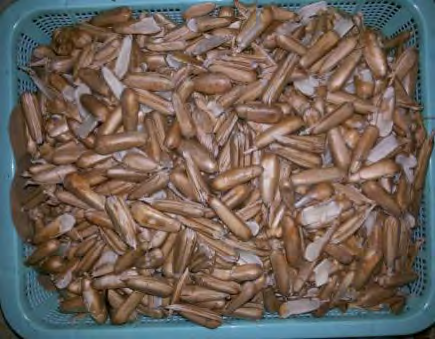The Language Designed to Protect the Nuts
The island of New Guinea sits just north of Australia (here’s a map). It’s divided into two sections: the western half is part of Indonesia, and the eastern is the independent nation of Papua New Guinea. And if you travel to Papua New Guinea (PNG), there’s a very good chance you’ll have an opportunity to eat some of these:

Those are pandanus nuts, the nuts from the pandanus tree native to some of the deepest forests in PNG. And for centuries if not longer, they’ve been a significant food source for local residents. The nuts taste like a mix of coconuts and walnuts, and they’re are surprisingly nutritious, comparing favorably to coconuts (which aren’t actually nuts) and most other tree nuts. According to Wikipedia’s editors, citing a research paper from 1996, “there is high demand for it in the New Guinea Highlands: Entire households (including pigs, who are sometimes fed the fruits) will move from the valleys to higher elevations at harvest time.” Pandanus nuts are a serious business in PNG.
Which is why you need to learn the special language used only while harvesting the nuts.
Papua New Guinea is home to 8.9 million people but also to about 850 languages, and there isn’t one overall dominant language. The official language is Tok Pisin but only about two-thirds of the country is literate in the language; English is spoken widely as well — it is used by the government as the default language and about 40% of the country can speak, read, or otherwise understand it. In some rural areas, neither language is common. The people who live in the regions where pandanus trees are common often speak Kewa, something that only about 100,000 people speak.
But unfortunately, as legend has it, whatever lurks in the pandanus forests speaks it as well. And that’s a problem if you’re on the hunt for pandanus nuts. According to the 1986 book The Papuan Languages of New Guinea, “the pandanus trees grow in the deep forest in areas inhabited by nature spirits and wild animals, [making the area] a place dangerous to human activities.” Early inhabitants of PNG feared what would happen if the spirits and creatures found out what the nut gatherers were up to — they concluded, quite reasonable for peoples who believe in nature spirits — that these bogeymen would not like it when people trespassed into their forests to steal their nuts.
To account for this, communities across PNG have established a language of sorts that is only used when in the forests of the pandanus trees. Atlas Obscura explains:
On pandanus-gathering expeditions, ordinary words cannot be spoken. Instead, people use pandanus talk. It is not a language of its own like Russian or Mandarin, but a style of language used in a special context, or what linguists call a “register.” Across Papua New Guinea, different clans with different languages all switch up their speech when they gather pandanus, lest they risk harming the harvest.
The “pandanus nut language,” as these registers are often called, are passed down from generation to generation. The language consists mostly of codewords and euphemisms> For example, per the above-cited book, the word “maeye” means “crazy” in Kewa but is “generally for any kind of animal other than a dog” by those on a nut expedition. The thinking behind the replacement? Per the book, those animals “are opposed to the rational world of man, and, perhaps, dogs [and are therefore ‘crazy’].” Even those who haven’t been specifically taught the special nut-collecting lexicon may, therefore, be able to figure out what a pandanus nut language speaker is saying, given appropriate context clues.
And that’s a good thing, too, because in most cases, the nut language isn’t used outside of the taboo forests. Generations ago, people feared that the nature spirits could spy on the conversations that took place even beyond the forests. The people believed that if the codewords were ever spoken in the context of regular speech, the spirits would be able to decipher the true meanings of the swapped words, rendering the scheme obsolete. If nut language was used outside of the forests, therefore, the words would have to be replaced. So if you want to hear the nut language in practice, you’ll have to go to Papua New Guinea and go foraging for nuts.
Bonus fact: Papua New Guinea has so many languages that if you were to select two people and random, there’s roughly a 99% chance that they would have two different mother tongues. This ranks the nation at the top of both major language diversity indices, as seen at Wikipedia, here. For comparison’s sake, in the United States, there’s only about a 33% chance that two people will have different first languages; in South Africa, it’s about 85%, and in South Korea, it’s about 1%.
From the Archives: Losing the Htrkos in the Woods: The word “bear” means “brown one” because people were too afraid to call bears by whatever they were really called. But we forgot what that word was because they stopped using it.
